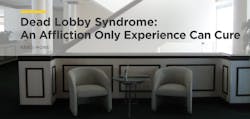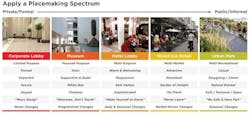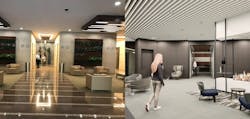Think about the building where you go to work every day. Are you inspired when you walk in the front door? Are you enticed to explore or investigate? Is there a place to stop and spend time with a friend or colleague? If pressed, could you even describe what the space looks like?
If any of these questions left you wondering, your building may have Dead Lobby Syndrome.
The Affliction
The competition for great tenants has rarely been as fierce as it is today. High vacancy rates, sublease glut and slow absorption have landlord reps and building owners searching for ways to distinguish and elevate their properties within their market. Dead Lobby Syndrome affects buildings of all vintages and all real estate classes. It does not distinguish between urban buildings with large, grand lobbies and suburban buildings with modest lobbies. Classic symptoms of Dead Lobby Syndrome include:
Absence of Purpose (Strategy)
Lack of Options (Engagement)
Indistinct Identity (Brand)
Forgettable Experience (Place)
These symptoms share one problem – lack of meaningful experience for the individual.
The Treatment
We have identified the problem and isolated the symptoms. Let’s explore different options for treatment.
Know your Neighborhood. Your building lobby is a small piece of a larger neighborhood. Study your surroundings. Analyze what is working in other properties around you, and then compliment (not copy) those existing amenities with services that are missing or under-served. Create a Brand and a Place that amplifies the unique qualities of your neighborhood.
Provide a Purpose. Public spaces come to life when they are given a purpose. They stay alive as long as the purpose is interesting, useful or enlightening. The new purpose that will define your building lobby should be genuine and engaging, serving the community in and around your property.
Create Community. Are you in an urban environment with a wide variety of entertainment, dining and socializing opportunities? Your lobby redesign should complement those easily accessible amenities. Provide options that will benefit the larger community and bring visitors, commerce and new interest to your building. Or, are you on an island in the suburbs? What amenities could you bring to your lobby that would extend the time your tenants genuinely want to spend at your building, and thus in the community of their fellow tenants? With such busy schedules, services and amenities should improve the experience of coming to the office every day and help balance the work / life scales.
The Cure
At PDR we have defined a Spectrum of Place that focuses on the experience of being in different places. Our Brand Strategists and Designers can help you define the current versus the desired feel for your property.
As we begin design, PDR will focus our efforts around the three qualities that all successful experiences share: energy, collegiality and connection to the natural.
The successful design solution will be a purposeful place with a lasting experience. In order for this experience to endure beyond the initial “wow” moment, PDR will create a menu of spaces that can be refreshed with minimal investment to the property owner. Managing and operating the program of these spaces is crucial, and often has staff dedicated to this effort in the form of Concierge or an Experience Curator that partners with local vendors, artists, speakers and teachers to keep the Purpose of the space alive.
An Integrated Solution
PDR believes the integration of Strategy, Engagement, Brand and Place is the true recipe for success when curing Dead Lobby Syndrome. We are designers, architects, brand specialists and business consultants who approach placemaking from the inside out – amplifying human experience in order to positively impact your real estate challenges.
Below view a sneak peak of the before and after images inside a current lobby project.
About the Author
PDR
Based in Houston, PDR specializes in the delivery of innovative workplace design and solutions. As a world-class, workplace consultancy and a premier creative design firm, our integrated services address both business requirements and the work environment to create high performance spaces designed to evolve over time. Check out our blog for more. Follow us on Facebook, LinkedIn, and Twitter.




